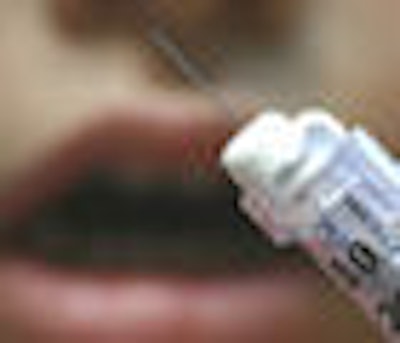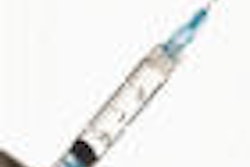
A 1:200,000 concentration of epinephrine anesthetizes patients just as well as a 1:100,000 concentration when used with articaine (Septocaine), researchers have concluded.
“This meta-analysis provided no evidence that the proportion of anesthetic success differed.”
— Kellie Paxton, D.M.D., M.S.
The researchers looked at every study they could find that compared the two different concentrations and used statistical formulas to combine the data. "This meta-analysis provided no evidence that the proportion of anesthetic success differed," said Kellie Paxton, D.M.D., M.S., who completed the research at the University of Iowa before beginning private practice in West Palm Beach, FL.
The U.S. FDA approved the 1:100,000 concentration, equivalent to 0.01 mg/mL or a 0.001% solution, in the year 2000, and didn't approve the more diluted concentration of 1:200,000 until 2006. The stronger concentration remains more widely used, said Dr. Paxton, who presented the results at the recent International Association for Dental Research (IADR) meeting in Miami.
Dr. Paxton and her colleagues found 257 studies comparing the two concentrations. But they rejected 250 of them because they didn't report on a dental application, weren't randomized trials in humans, or didn't measure clear anesthetic outcomes.
That left seven studies: three from Germany, three from Brazil, and one from the U.S. None reported a significant difference in the anesthesia achieved by the two concentrations.
The studies used electric pulp testing and/or intraoperative pain measurement to determine whether anesthesia had been achieved.
For example, in a study reported in 2007 in the Journal of Oral and Maxillofacial Surgery, researchers at the University of São Paolo randomly assigned 50 volunteers needing third-molar removal to one of the concentrations or the other (JOMS, December 2007, Vol. 65:12, pp. 2445-2452).
Those who had one concentration for the first extraction had the other concentration for the second extraction. Latency, duration of postoperative analgesia, and duration of anesthetic action on soft tissues were all similar between the two drugs (p > 0.05).
Using less epinephrine could have benefits since the drug has complex systemic effects. For example, it has been linked to arrhythmias and can interact with other drugs such as halothane. Patients with hypertension and peripheral neuropathy may be particularly sensitive to its effects.
"It is totally beyond the scope of this study to look specifically at epinephrine's systemic effects," Dr. Paxton said. "However, for a clinician wanting to expose their patient to less epinephrine, then this result of this report would support similar anesthetic success."
Yet there are cases in which dentists might still want to use the stronger concentration, said Paul Moore, D.M.D., Ph.D., M.P.H., the chair of the department of anesthesiology at the University of Pittsburgh School of Dental Medicine, a paid consultant to articaine maker Septodont, and an author of one of the meta-analysis studies.
Dr. Moore noted that the stronger concentration can reduce bleeding. "If you do periodontal surgery, you get less bleeding with 1:100,000," he said. "Otherwise, the bone just oozes, and it can be hard to see what you're doing."
Copyright © 2009 DrBicuspid.com



















